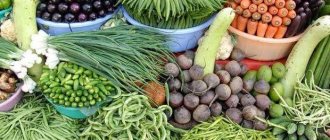How to conduct classes
Making each speech therapy session as effective as possible allows not only high-quality visual material, but also its correct use. There are several principles that are important to follow when working with pictures.
- Cards for children should have bright, realistic images drawn on a white background. It is better to use special kits for kindergarten; photography can also be useful.
- The younger the children, the more important it is to show images only of familiar, familiar objects.
- The number of pictures used in one lesson should correspond to the age of the child. For kids, 3-5 are enough; for older kids, you can take up to 10-15 cards.
- During the lesson, use subject and plot pictures on the same topic.
- First, you should introduce the children to the pictures, let them look at them well, and only then take the selected cards for educational games and activities.
Tasks
If you want to use pictures on the topic “Vegetables” during speech therapy classes for children, you can offer the following assignment options:
- Pick and describe
The child must sort the images according to “what grows in the garden and in the garden”, and then tell in detail about one or several vegetables.
- List the characteristics of the object
A picture with a vegetable is selected. Then you need to list its characteristics (beets - burgundy, large, round, young, washed).
- Make up a story
Using a plot picture with vegetables, you can come up with a story on the theme “Harvesting” or “Little gardeners.”
Harvesting Little gardeners
- Come up with questions
Based on one subject picture with a vegetable, come up with as many questions as possible:
Where does it grow? What color does it come in? What does it resemble in shape? What dishes can be prepared from it?
- Describe the picture
Invite your child to talk about the vegetable he has on the card: list the external signs, where it grows, and in what form it is eaten.
- Lay it out and tell it
Ask them to sort the images into three groups: what grows underground, in the garden, on a bush.
Cabbage vegetables
As the name suggests, cabbage vegetables are different varieties of cabbage. In general, only a few varieties are widely used.
Fruit Skewers Children cut the fruit into pieces and ask the children to place them on the wooden stick from which you cut the pointed end. Small red carpet tiles. Apple apple and apple. To the garden, to the garden We'll go, We'll go, to go, to choose. Beautiful apples, beautiful apples.
In the trees, in the trees We rise, we rise to pick the apples, pick the apples. Very juicy, well juicy! Fruits and vegetables are allies of health. Tips for maintaining their nutritional quality. Fruits and vegetables contain many nutrients. These include mainly dietary fiber, minerals and minerals.
The most famous is white cabbage. It is divided into three types: early, late and middle.
This cabbage looks like a round head of white-green color. The leaves have veins. For planting you should choose sunny places. It is not frost-resistant and grows at temperatures from 13 to 18 degrees. For cooking, it is better to use round-shaped cabbage. The oblong one is looser and is not always suitable for the dish.
Offer them to your little ones with their peel, as the latter contains most of the dietary fiber as well as vitamins and minerals. Offer your children the most colorful fruits and vegetables: they contain more vitamins and minerals. Encourage fresh fruits and vegetables. . Because they are living foods, fruits and vegetables breathe even after they have been harvested. Therefore, various environmental processes seek to slow down their breathing in order to delay the undesirable consequences that may arise as a result.
Cold is the preferred preservation method. Most fruits and vegetables stay cold. Keep almost all fruits and vegetables packaged separately in refrigerated drawers for this purpose. These drawers are the coolest and wettest places in the refrigerator. Make sure the bags allow air to circulate around the different foods.
It has red or purple leaves and differs from cabbage only in shade. Mainly used for salads.
Brussels sprouts are a smaller version of cabbage sprouts. It grows on thin stems; one can produce up to 100 heads of cabbage. And the weight of one head of cabbage is approximately 10 grams.
Cauliflower. Only the upper part is eaten. It is very capricious in storage, it can deteriorate after being in the sun for just a little while.
Any type of cabbage vegetables contains many vitamins, minerals and other beneficial substances.
Games
- What a harvest!
The players take turns taking one card with a picture of a vegetable and passing it around the circle, naming its characteristics. The last one to come up with an answer wins. Then the game is repeated again, but with a different card.
- Let's cook lunch
Each player chooses three pictures with vegetables. You need to correctly name the dish that can be prepared from each. Example:
eggplant, tomato, pumpkin - eggplant caviar, tomato soup, pumpkin juice; potatoes, zucchini, cucumber - mashed potatoes, zucchini pancakes, cucumber salad.
- What's extra?
Select four pictures so that three have something in common, and the fourth is superfluous. Example:
carrots-turnips-tomatoes-beets (all grow underground, but tomatoes do not) tomato-eggplant-radish-bell pepper (extra radishes, grow underground)
Older preschoolers can be offered more complex versions of this game:
tomato-potato-carrot-cucumber (potatoes are not eaten raw, they are extra).
- Writing riddles
Ask your child to choose one image from the Vegetables or Vegetable Garden set, and then make a wish for what is drawn. Children 3-4 years old are trained to describe only the features of an object from a selected picture, while older children can already come up with much more complex constructions, even short funny poems.
Types of vegetables
- Tubers.
- Roots.
- Salad.
- Brassicas.
- Bulbous.
- Spicy.
- Solanaceae.
- Cereals.
- Pumpkin.
- Legumes.
- Dessert.
Vegetables are eaten in different forms. Which vegetable is eaten only raw, and which, on the contrary, only fried or stewed depends on the person’s preferences. After all, there are people who adhere to a kind of food system called a raw food diet, that is, they eat everything only in raw form. Vegetables are used in dietary nutrition because they have virtually no fat. Every day, a healthy adult should consume no less than 600 grams of vegetables in any form.
Can be consumed in several forms, in juice or in fruit salad, in jam, in sauces. Mainly used to decorate dishes and desserts. It is perfectly adapted to the climate of the West Indies, where it is a minor food item. The bread tree is 10 to 12 meters tall. The fruit weighs from 1 to 3 kg. The flesh is eaten as a vegetable after being cooked with salt water.
It was the Spaniards who discovered this in the Greater Antilles. The tree and fruit are called "nono" in Tahitian, the fruit is first green then yellow, it turns whitish when ripe, the tree and fruit are known to have medicinal virtues. "Noni" is the name given to the juice extracted from the fruit pulp - thanks to Corina, who contacted us to help us identify this fruit.
Tubers
- Sweet potato. Or sweet potatoes. The height of the bush is 15-18 cm.
- Potato. They are a very important food product. If you store potato tubers in light, they turn green. This is due to the solanine they contain.
- Jerusalem artichoke. Or an earthen pear. It is a valuable technical, food and fodder plant.
Roots
- Swede. Biennial plant. The growing season lasts about 110 days.
- Carrot. Biennial plant. The most famous is carrots. Cultivated carrots are divided into fodder and table carrots.
- Parsnip. Used in food as a spice. Parsnip root is usually used in food.
- Parsley. Both leaves and roots are used. Freshly frozen parsley retains its beneficial properties for several months.
- Radish. Root vegetables are used for food consumption.
- Radish. In our region, we mainly use radish, which is not found in the wild.
- Turnip. Forage varieties of turnips are called “turnips”.
- Beet. Sugar beet, common beet and fodder beet are the most famous representatives.
- Celery. Distributed on all continents except Antarctica. All parts of the plant are edible.
- Horseradish. It is the basis for a table seasoning called horseradish.
Brassicas
- Garden cabbage. Distributed in countries with a temperate climate.
- Red cabbage.
- Savoy cabbage.
- Brussels sprouts. Small pumpkins are eaten as food.
- Cauliflower. Valuable for its dietary qualities. They eat boiled heads.
- Broccoli. The vegetable is very rich in vitamins.
- Kohlrabi. The stem is eaten.
Salad
- Leaf salad.
- Romaine salad.
- They contain very few calories and a lot of vitamin A and folic acid.
Spicy
- Dill. It has a very spicy taste and smell.
- Tarragon. Also called tarragon wormwood or tarragon. Very common.
- Savory. Popular seasoning. In many cuisines around the world it is used for salting and pickling.
- Basil. Popular seasoning. Added to many dishes.
- Marjoram. Used as a seasoning. Essential oil is extracted from the upper part of the plant. Improves digestion, has a sedative and diuretic effect.
Bulbous
- Bulb onions. The most important vegetable crop. Both leaves and bulb are used. Most often, they are either consumed raw or roasted. Also canned and pickled.
- Garlic. Popular all over the world. Used medicinally for its antiviral effect. In cooking it is used raw or cooked, as well as a seasoning. The leaves, arrows, and flower stalks are also edible and are used on young plants. Only the roots of the plant and the thin protective husk of the cloves are not eaten.
Tomato
- Tomato. Tomato fruits are called tomatoes. The fruits are used in cooking in any form. The fruit type is berry. The fruits are eaten fresh, boiled, fried, or canned; tomato paste, various sauces, juices, and lecho are prepared from them.
Pumpkin
- Pumpkin. This vegetable is eaten after heat treatment. Well absorbed by the body.
- Zucchini. The fruits of the vegetable are oblong-shaped and white, green or yellow in color.
- Squash. Cultivated all over the world.
- Cucumber. Important for metabolism. Improves digestion, heart and kidney function. Stimulates appetite. When eaten fresh, it increases the level of acidity in the stomach.
Legumes and grains
- Peas. Peas are the most common variety.
- Garden bean. It is grown as a food and feed crop. Popular among different nations.
- Sweet corn. Or maize. Has wide culinary uses. The cobs are boiled. Sometimes frozen for storage. Canned corn is often used in salads.
Dessert
Let's look at what dessert vegetables there are.
It is named "Ababai" by the Caribbean Sea. It was undoubtedly imported, its origin unknown. Tree: cinnamon or attic apple tree. Beneath the tough scales of the cinnamon apple there is white flesh, tender, sweet and aromatic, which is eaten as is. Tree: Kythera plum tree or Kythera apple or Kythera tree. Can be consumed in different forms.
The Indians used it to paint their faces. Also used to color sauces. Sapotil: "brown balls" with clear green flesh and black seeds. This fruit has a lumpy pear like guava. This would be the sweetest fruit of Guadeloupe. It secretes a sticky white sap when separated from the tree. Rarely in Guadeloupe do locals keep this to themselves.
- Artichoke. The fleshy stalks of the prickly artichoke are eaten, and the petioles of the Spanish artichoke. Very widely used in cooking. Asparagus. The most common type is common asparagus. There are different types: grass or shrub. The tops of asparagus are a culinary delicacy.
- Rhubarb. The petioles are used in cooking. To grow tender petioles, the plant needs to be surrounded by a barrel; the shaded petioles will stretch towards the light, and when they stretch out, they will acquire a certain tenderness.
Now you know what vegetables there are and their beneficial properties. This will allow you to organize your diet so that your body is constantly fed with healthy foods and natural vitamins. In addition, vegetables are incredibly beneficial for a growing child's body. Therefore, try to eat more of them.
Vanilla is a kind of orchid. Vanilla production in Guadeloupe is very minimal. This is a fruit that cannot be put into all hands! It's edible, but not without danger. Ackee is not edible in general: only the fleshy arils that overcome the seeds are edible, and the rest of the fruit and seeds are very toxic. The fruit should be picked only after it is completely open, and it should be fresh and not bitter.
You will understand, if in doubt, abstain, do not consume this fruit! The question is whether vegetables grow fruits or vegetables, and the answer offers some surprises. Do you know the difference between fruits and vegetables? While most fruits and vegetables are easy to distinguish and classify, sometimes it is difficult to tell whether something is a vegetable or a fruit. For example, a tomato is often considered a vegetable, but is actually a fruit.
The word vegetables can mean different things. Often in cooking this term is used in relation to those products that in botany have nothing to do with the concept of vegetables.
Types and varieties are divided into several types, depending on appearance, growth and what part of the vegetable is eaten.
The confusion about "fruits" and "vegetables" stems from differences between scientists and chefs. They are studied in agronomy and agroecology, agriculture, etc. According to botanists, the fruit is part of a plant that develops from a flower. It is also the part of the plant that contains the seeds. Other plant parts are considered vegetables. The fruit is considered the edible organ of flowering plants, which thrives in each flower and protects the seeds, kernel or peppin inside it. Many people associate fruits with sweet foods, but this is not true, there are even some salty seafood that are fruits.









